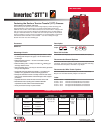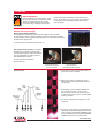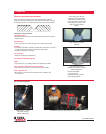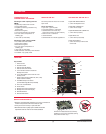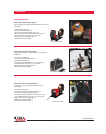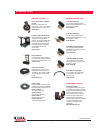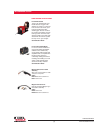
Invertec® STT® II
[3]
A CLOSER LOOK
• Superior weld profile
(no wagon tracks)
• Slight convexity of root weld
• Low hydrogen deposit
Stick welding with cellulose
electrodes provides good fusion
characteristics, but leaves deep
wagon tracks (requiring more labor
for grinding), a very convex root
weld, and a high hydrogen
deposit.
Open Root Pass with STT
provides a weld ligament thickness
of approximately 0.22˝.
Open Root Pass with Stick
Electrode
www.lincolnelectric.com
USING STT FOR OPEN ROOT WELDING
Open root welding is used for pipe and single-sided plate welding in
situations that preclude welding from both sides of the material. This type
of welding is common in the petrochemical and process piping industries.
Advantages of STT Open Root
Penetration Control
• Provides reliable root pass and complete back bead. Ensures excellent
sidewall fusion.
Cost Reduction
• Uses 100% CO
2
, the lowest cost gas, when welding carbon steel.
Flexibility
• Provides the capability of welding stainless steel, nickel alloys, and mild
or high strength steels without compromising weld quality.
• Capable of welding out of position.
Low Heat Input
• Reduces burnthrough and distortion.
Low Hydrogen Weld Metal Deposit
Speed
• High quality open root welds at faster travel speeds than GTAW.
Current Control Independent of Wire Feed Speed
• Allows operator to control the heat input to the weld puddle.
Ease of Operator Use
• More forgiving process than conventional short arc welding with
CV machines.
STT Open Root Application
Inside of an 8 in. x .375 in.
wall API 5L-X52 pipe,
welded in 5G position.
STT process using 100% CO
2
and .045 in. (1.2mm) wire.



